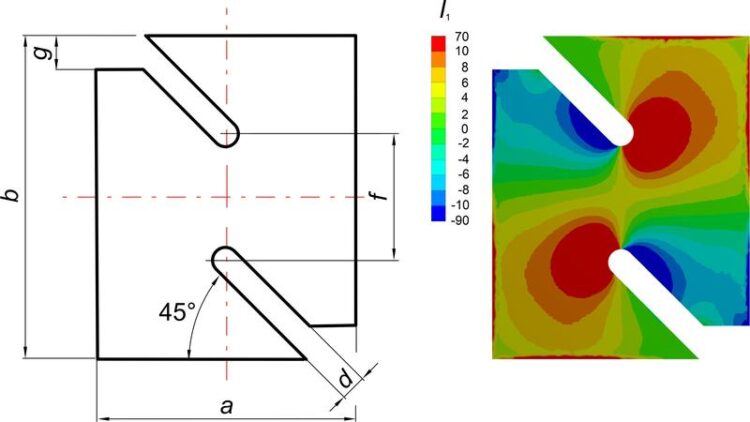Optimized Specimen for In-Plane Shear Test

Left: In-plane shear specimen loaded on tension in the vertical direction
Fraunhofer LBF
For quality control and damage assessment of injection-moulded components, simple and cost-effective tests are desired. Preparation of the standard test specimens is sometimes costly. In this case, the specimens taken from the flat areas of the component can be preferred. Scientists at the Fraunhofer LBF have improved known in-plane geometry for the shear test. Together with the modified loading schema, the new procedure is reliable and can be used for a wide range of materials. The new test specification is especially developed for SME’s to reduce the costs of the component development and also by quality control. The manufacture of special test specimens is obsolete.
In context of realistic loading scenarios, the in-plane-shear test offers one of the easiest possibilities of the materials survey. But the known test specifications are restrictive. Fraunhofer Institute for Structural Durability and System Reliability LBF has modified the known test specification so that the measuring region of the specimen is enlarged and the stress concentrations by the force introduction are significantly reduced. In this way, parts for automobiles, components in aircraft construction or products from sports, medicine, and household can be designed more reliably and more cost-effectively.
In-Plane Shear Specimen
Slotted shear specimens have been established for material characterization in research and commercial applications. This test specimen is loaded on tension in the vertical direction. Field under shear stress will accrue between the notch tips. The deformation gradients are recorded during the test and evaluated subsequently with digital image correlation.
Reliable implementation of the test requires correct positioning of the specimen in the fixture and skilled personnel to perform the evaluations. Due to the stress concentrations in the tip of the notch, this test is suitable for relatively ductile materials. Some limitations arise when being used for short fiber reinforced thermoplastics and laminates.
For the simple stress analysis of the specimen, we use the sum of the normal stresses or the first invariant of the stress tensor I1. This sum is equal zero in the case of the shear loading. For reliable test results the shear field must be increased and the stress concentrations significantly reduced.
Optimized Geometry of Specimen
At Fraunhofer LBF researchers managed to develop a novel shear specimen that overcomes the major drawbacks of the known specimens. Special geometric and loading design allows homogenized shearing field and reduced tensile stress concentrations in the tip of the notches.
The comparison of the areas with I1=0 shows an increase of the shear region in the measured field. The tip of the notch in the modified geometry is under compression. It is visible that the stress peaks are reduced.
This shear test can be performed in the conventional tensile testing machine. Stability loss of specimen is excluded constructively. The tests can be carried out under the influence of temperature and time. The relaxation experiments provide the data for the material cards of the commercial FEM codes. An extended shear field increases the accuracy of the measurement. This test is feasible for a different class of materials including brittle materials.
Wissenschaftliche Ansprechpartner:
Dr.-Ing. Vladimir A. Kolupaev, vladimir.kolupaev@lbf.fraunhofer.de
Dipl.-Ing. (FH) Axel Nierbauer, axel.nierbauer@lbf.fraunhofer.de
https://www.lbf.fraunhofer.de/en/press-releases/in-plane-shear-test.html
Media Contact
All latest news from the category: Materials Sciences
Materials management deals with the research, development, manufacturing and processing of raw and industrial materials. Key aspects here are biological and medical issues, which play an increasingly important role in this field.
innovations-report offers in-depth articles related to the development and application of materials and the structure and properties of new materials.
Newest articles

NASA: Mystery of life’s handedness deepens
The mystery of why life uses molecules with specific orientations has deepened with a NASA-funded discovery that RNA — a key molecule thought to have potentially held the instructions for…

What are the effects of historic lithium mining on water quality?
Study reveals low levels of common contaminants but high levels of other elements in waters associated with an abandoned lithium mine. Lithium ore and mining waste from a historic lithium…

Quantum-inspired design boosts efficiency of heat-to-electricity conversion
Rice engineers take unconventional route to improving thermophotovoltaic systems. Researchers at Rice University have found a new way to improve a key element of thermophotovoltaic (TPV) systems, which convert heat…



